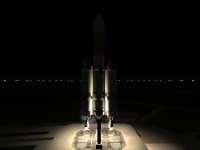
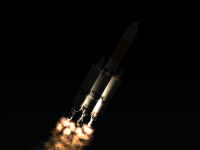
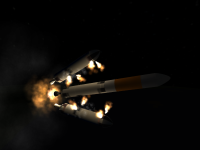
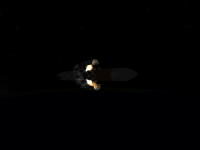
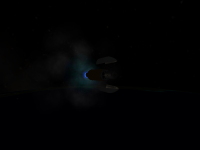
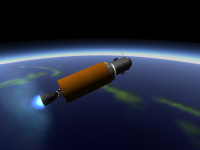
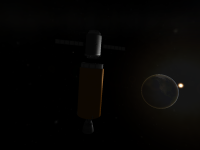

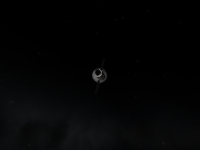

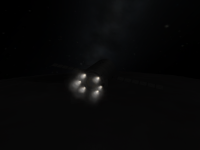
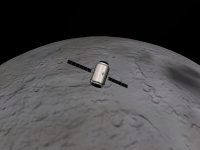
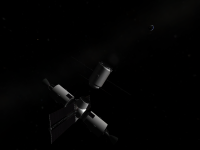
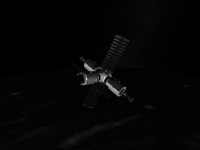
TLF-3 was a manned lunar orbit using the Delta Taxi Mk II (callsign "Deliverance") in conjunction with the Napier 1 spaceplane (mission NTF-11). The multiple-launch architecture also involved a CDEDS and a Hobbes life-support supply vessel, and made use of the Legendre Space Station in LEO at 400km/28.6°, as well as the Lebesgue Propellant Depot in LLO.
This 'C-class' lunar mission followed the 'B-class' TLF-2 orbit of eleven months earlier. Thanks to technological improvements, we were able to increase the performance of various vehicles without raising GLOM. Indeed, it was the need for extra performance (including unlimited relight capability) on the Delta Taxi which necessitated such a long wait between missions; fortunately we were able to use the time to fly several propellant tankers to Lebesgue giving it stocks sufficient not only for this C mission but also the D-class (landing) mission planned to follow it.
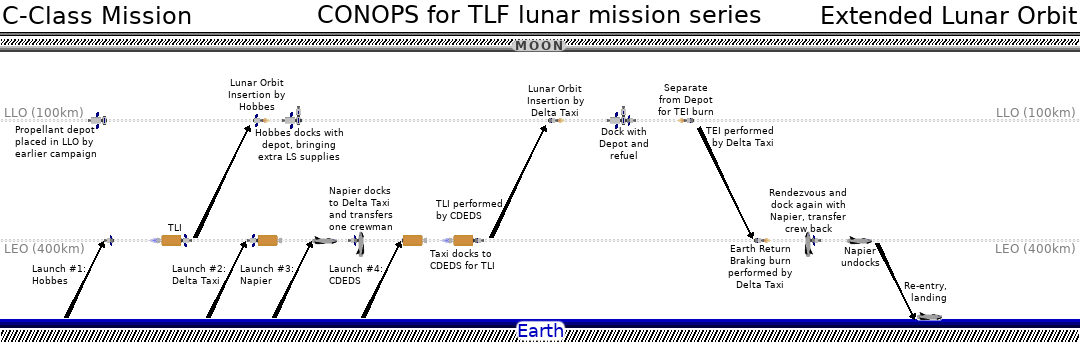
CONOPS diagram for this C-class extended lunar orbit mission.
The first launch of the campaign took place well in advance of the rest, on the 7th of January 1965. This cargo vessel with its non-perishable life-support supplies was derived from the standard Hobbes that has kept first Lagrange and now Legendre Space Station running. However, since entering LLO to reach Lebesgue requires far more manœuvring delta-V than docking with a station in LEO, the Hobbes/L gives over more of its internal volume to propellant tanks, leaving room for only about 34 astronaut-days of life-support supplies (rather than the 90+ of the standard version). Fortunately this will still be enough for multiple lunar missions, as the durations involved are much shorter than the Station habitations.
Another difference from the standard Hobbes is that the Locke 2B rockets used to place those in LEO are of course insufficient for TLI. Instead Hobbes 6/L launched on Leibnitz DC9, a Leibnitz/Centaur using the new lightweight-tank 'Centaur C+' upper stage.
The Delta Taxi Mk II "Deliverance", a one-man spaceship with 4,230m/s of ΔV (through its AJ10-118F ERPS) and no atmosphere capability, launched on the 29th of August 1965, atop Leibnitz DE9. This is similar to the ’DE6 that launched Sojourner, but taking advantage of a few Leibnitz family upgrades, notably the lightweight tankage in both the Tartaglia sustainer and the Leibnitz LFB, as well as the LR105-NA-7.2 engine in the former. From launch to docking at Legendre Space Station took just over eight hours.
Napier 1, a two-man spaceplane with 2km/s of orbital insertion/manœuvring capability from its XLR81-BA-13 engine, launched for NTF-11 on 2nd September, 1965, on the Leibnitz DH13 booster (basically identical to the ’DH11 for TLF-2). This was our 23rd spaceplane launch, and the 14th flight of Napier 1.
The crew of the Napier were Rebecca Reid (pilot) and Catherine Graves (passenger). Rebecca had previously been a passenger twice on her way to fly Delta Taxis ("Quester" for TPF-1 and "Sojourner" for TLF-2); this was her first time in the front seat. Catherine is a spaceflight veteran having made two trips to the old Lagrange Space Station (flying as a passenger both times) with a total of three months on-orbit.
CDEDS 3 launched atop Euler A*12 at 1251Z on the 3rd of September 1965. The Euler and CDEDS were basically unchanged from TLF-2; the only difference is a slightly higher propellant fill on the Volta first stage.
With the CDEDS holding position 25m away from Legendre Space Station (2½ hours after the Euler A*12 launch), Catherine Graves undocked Deliverance from the Station and flew across to meet and dock with it at 1542Z. Just under an hour later, at 1634Z, the TLF-3 stack commenced its 3,125m/s trans-lunar injection burn. This took over seven minutes, ranging from 0.53g at the beginning to 1.09g at the end. The empty CDEDS was jettisoned at 1809Z by which time Deliverance was 25,000km above the surface of the Earth.
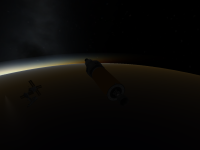 |
 |
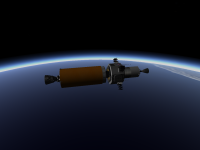 |
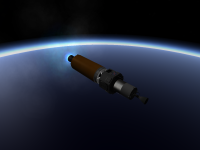 |
| TLF-3 stack assembled | Drifting away from Legendre | Preparing for the TLI burn | TLI in (slow) progress |
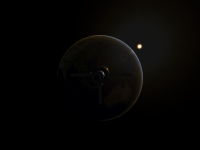 |
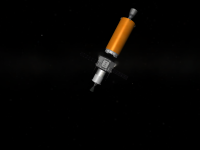 |
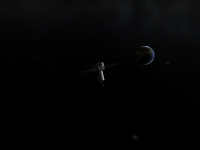 |
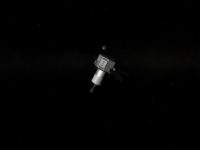 |
| Leaving Earth behind | Undocking from the CDEDS | Crescent Earth | Grey button Moon |
Deliverance entered lunar space at 5AM on the 6th of September, and 15½ hours later made a 70-second 709m/s burn to insert into 1,151×72km lunar orbit (with a relative inclination to Lebesgue of just 0.04°). After completing one 170-minute phasing orbit, a further 168m/s burn brought the aposelene down to 123km. After a little more orbital manœuvring, Catherine docked her ship to the Lebesgue Propellant Depot at 0129Z on September 7th, transferred some propellant and life-support supplies across to Deliverance, and settled down for the orbital stay.
After 48 hours at Lebesgue, it was time to head back to Earth. The 784m/s TEI burn began at 0155Z on the 9th of September, lasting about 75 seconds and putting Deliverance on course for a 391,981×105km geocentric orbit. A 3m/s TCM shortly after leaving the lunar SOI raised the perigee to 200km.
After 4½ days of coasting, Deliverance finally fell back into the depths of Earth's gravity well and, at 1745Z, commenced the 167-second, 2,895m/s Earth Return Braking burn, over the Atlantic just off South Africa. After this burn, which peaked at 2.9g, the Delta Taxi Mk II was in a 1,085×199km orbit. A couple more burns, 56 and 52 m/s at 1836Z and 1926Z respectively, brought it to 883×398km. After seven phasing orbits, at 0647Z on September the 14th, it was a mere 3½km from Legendre Space Station as it made a 132m/s burn to match velocities. By 0722Z the Taxi was just 36 metres from the Station, holding position and awaiting orbital sunrise; the docking was made visually at 0730Z. Margins were 68m/s of ΔV and about 41 hours of life-support.
Rebecca Reid flew a very gentle re-entry profile, with an initial 192×60km trajectory. 30 minutes after crossing the Kármán line, after a smooth descent and a circuit of the Space Centre, Napier 1 landed at Cape Canaveral at 1215Z, having spent twelve days in orbit.
With the Lebesgue-refuelled lunar orbit architecture proven and reliable, the next step will be the D-class mission to visit the lunar surface. A lunar lander has been designed and the prototype is currently being prepared for a test flight (LPF-1) in low Earth orbit. Meanwhile, Deliverance will be refuelled ready to take part in TLF-4 when it will ferry an astronaut to a lander waiting at Lebesgue.
Other upcoming launches include Euler C0 — the test flight of a new seven-engined booster and stretched Eulerian upper stage to loft an 18-ton mass simulator — and the Tycho 11 high-resolution lunar mapping satellite on Leibnitz DB4.